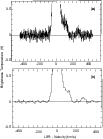 |
Figure 3:
H I profiles from the IAR survey at l = 293
|
The main scientific drivers of this new high sensitivity survey are the study of:
 |
Figure 3:
H I profiles from the IAR survey at l = 293
|
The results of the IAR H I Southern Sky Survey![]() have been used to produce Figure 1,
in which the integrated neutral hydrogen profiles, over the
entire observed velocity range, are shown, on an Aitoff projection. The
integrated intensities are represented by a gray
scale, where the lowest intensities are represented by black, and the largest
one, approximately 12000 K kms-1, are depicted by white. In this figure
are clearly seen both the galactic plane between l = 240
have been used to produce Figure 1,
in which the integrated neutral hydrogen profiles, over the
entire observed velocity range, are shown, on an Aitoff projection. The
integrated intensities are represented by a gray
scale, where the lowest intensities are represented by black, and the largest
one, approximately 12000 K kms-1, are depicted by white. In this figure
are clearly seen both the galactic plane between l = 240![]() and
l = 20
and
l = 20![]() (with the galactic center in between), showing the various
extensions at both sides of it, and the Magellanic System
(with the galactic center in between), showing the various
extensions at both sides of it, and the Magellanic System![]() .
.
Global properties of the whole sky H I distribution can be appreciated in Fig. 2, which shows the same kind of display as Fig. 1, but with the addition of the Northern sky data as obtained by Hartmann & Burton ([1997]). This is the first time that such a display, with uniform data, is shown.
As mentioned above, the present survey will also be useful to build a new database of High Velocity Clouds (HVC), achieving a much better sensitivity, spatial resolution, and spatial coverage than in previous HVC surveys previously conducted (Morras et al. [1999]). This new H I survey will also allow to study in much more detail some of the HVC complexes known to date. Figures 3a and b are examples of the high quality of the IAR survey. Figure 3a shows the original data, while Fig. 3b shows the same data but convolved to a velocity resolution of 8 km s-1.
Acknowledgements
This survey has been made possible, from the instrumental point of view, by the availability of a cooled receiver and a digital autocorrelator. The financial support obtained through a bilateral agreement between the Consejo Nacional de Investigaciones Científicas y Técnicas of Argentina (CONICET) and the Karlsruhe Forschungszentrum of Germany was crucial for developing the new front-end as well as the cooperation and support provided by the the Max-Planck-Institut für Radioastronomie through its Director, Dr. R. Wielebinski, and the electronic staff, headed by Eng. W. Zins and A. Schmidt, their help made it possible for Eng. J. Groismann (from the IAR) to build the receiver. For the digital backend we are also grateful to the Cornell University and the staff of the Arecibo Observatory for the equipments and the advices. Two of us (E.M.A. and J.J.L.) wish to thank the staff of the NAIC, with special mention of J. Hagen, M. Davies, R. Giovanelli and D. Campbell, for their warm hospitality and all the attention received during our stay at the Observatory. We would also like to thank the whole technical staff of the IAR for their constant attention to the radiotelescope. This work was partially supported by the CONICET under project PIP-4253/96.
Copyright The European Southern Observatory (ESO)